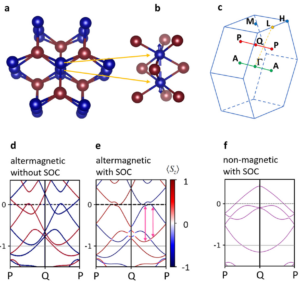The new exciting topic of altermagnetism is reaching further attention in German media. Recently Deutschlandfunk reported about our work and its representation at the DPG Frühjahrstagung in Berlin. You can find the contribution here.
Month: March 2024
25.03.2024 Altermagnetism is being recognised in the general media
09.03.2024 New publication about altermagnets
A publication with Jairo Sinova, Libor Šmejkal, Anna B. Hellenes, Rodrigo Jaeschke Ubiergo and Venkata K. Bharadwaj about supercell altermagnets has been published in Physical Review B.
 They substantially broaden the family of altermagnetic candidates by predicting supercell altermagnets. Their magnetic unit cell is constructed by enlarging the nonmagnetic primitive unit cell, resulting in a nonzero propagation vector for the magnetic structure. This connection of the magnetic configuration to the ordering of sublattices gives an extra degree of freedom to supercell altermagnets, which can allow for the control over the order parameter spatial orientation. They identify realistic candidates MnSe2 with a d-wave order, and RbCoBr3, CsCoCr3, and BaMnO3 with g-wave order. They demonstrate the reorientation of the order parameter in MnSe2, which has two different magnetic configurations, whose energy difference is only 5 meV, opening the possibility of controlling the orientation of the altermagnetic order parameter by external perturbations.
They substantially broaden the family of altermagnetic candidates by predicting supercell altermagnets. Their magnetic unit cell is constructed by enlarging the nonmagnetic primitive unit cell, resulting in a nonzero propagation vector for the magnetic structure. This connection of the magnetic configuration to the ordering of sublattices gives an extra degree of freedom to supercell altermagnets, which can allow for the control over the order parameter spatial orientation. They identify realistic candidates MnSe2 with a d-wave order, and RbCoBr3, CsCoCr3, and BaMnO3 with g-wave order. They demonstrate the reorientation of the order parameter in MnSe2, which has two different magnetic configurations, whose energy difference is only 5 meV, opening the possibility of controlling the orientation of the altermagnetic order parameter by external perturbations.
08.03.2024 New Joint Publication in Altermagnetic Transport
A joint publication with Jairo Sinova, Libor Šmejkal, Anna B. Hellenes, Rodrigo Jaeschke Ubiergo, Warlley H. Campos, Venkata K. Bharadwaj and Atasi Chakraborty about the direct observation of altermagnetic band splitting in CrSb thin films has been published in Nature Communications.
They investigate directly this unconventional band splitting near the Fermi energy through spin-integrated soft X-ray angular resolved photoemission spectroscopy. The experimentally obtained angle-dependent photoemission intensity, acquired from epitaxial thin films of the predicted altermagnet CrSb, demonstrates robust agreement with the corresponding band structure calculations. In particular, they observe the distinctive splitting of an electronic band on a low-symmetry path in the Brilliouin zone that connects two points featuring symmetry-induced degeneracy. The measured large magnitude of the spin splitting of approximately 0.6 eV and the position of the band just below the Fermi energy underscores the significance of altermagnets for spintronics based on robust broken time reversal symmetry responses arising from exchange energy scales, akin to ferromagnets, while remaining insensitive to external magnetic fields and possessing THz dynamics, akin to antiferromagnets.
01.03.2024 EU funding for outstanding early-career researcher Pieter Gunnink
We are proudly announcing that Pieter Gunnink has been awarded an individual fellowship provided through the Marie Skłodowska-Curie Actions program, which supports the Mainz physicist to carry out a new research project in the field of spintronics. Please read the original press statement here.
